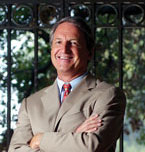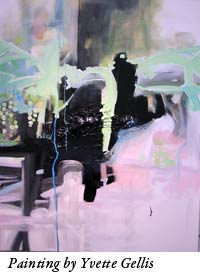|
 Great Conversations that Matter Great Conversations that Matter
Greenland Is Like the Moon
is the working title of a forthcoming book by Jeff Davenport. The
book explores analogies, metaphors, and similes. When I saw Jeff
recently for the first time in three years, he was curious about my
almost two years at Claremont Graduate University.
“What’s it like?” he asked.
What could I say to Mr. Metaphor? Should I compare Claremont to an
intellectual candy store? A cornucopia of ideas? A rose?
Let’s back up one step, I thought. What is it that’s special and
different about Claremont Graduate University?
People at Claremont are remarkably cordial, I told Jeff. They are
willing and able to talk across disciplines. They are interested
in the real world. All this contrasts in welcome ways with the academic
hostility, insularity, and theoretical narrowness that characterize
many universities.
“Why is Claremont that way?” Jeff asked.
I could only hypothesize. Claremont Graduate University shares the
liberal-arts-college DNA of the Claremont Colleges. Claremont’s small
size enables intimacy. We have a lovely, welcoming campus, a kind of
oasis in Southern California.
The Claremont culture is also intentional. Over the years, professors
and students and staff have worked hard to create a humane,
adventurous, and relevant educational experience. While other academic
institutions are accused of increasing precision on ever more
irrelevant issues, a disproportionate number of professors and students
at Claremont take on the most important issues of our region and our
world with a distinctive Claremont combination of transdisciplinarity,
rigor, and flair.
Maybe I was now ready to supply Jeff with a telling phrase about Claremont.
I told him about the plaque on the DesCombes Gate with a quote from our
first president, James A. Blaisdell. “The center of a college is in
great conversation, and out of the talk of college life springs
everything else.” Claremont is graduate education that creates great conversations that matter.
Think of what “great conversations” require. Interlocutors who are
passionate and knowledgeable, open to new ideas and diverse viewpoints,
and civil. “Great conversations” require people who have learned to
express themselves clearly and succinctly. They also require people who
have learned to listen, and listen well.
Think of what “great conversations that matter” entails. In the context
of graduate education, these are conversations that can advance
knowledge, provide new perspectives, even reframe questions. “Great
conversations that matter” may even help create research and action
that can make the world a better place.
Claremont Graduate University is dedicated to great conversations that
matter—in the classroom and at leisure, in research and in social
action, within the university and outside it.
Examples of Great Conversations that Matter
Some of the great conversations are in courses. For example, under the
leadership of Professor Wendy Martin, CGU has pioneered
transdisciplinary doctoral courses, where second-year students from
many fields consider how collaborative research can shed new light on
fascinating, important issues. The topics of these T-courses range
widely, including “New Orleans: Legacy and Promise,” “Death and Dying,”
and “The Nature of Inquiry.” A new online, collaborative tool called
“the Claremont Conversation,” developed by a team led by Professor
Terry Ryan, enables groups of students to work together on research
proposals, which can be seen and commented upon by professors and other
students.
Many Claremont courses involve conversations across disciplines and
professions, as well as with leading practitioners. For example,
Professor Jack Schuster’s seminar on public policy and higher education
annually visits Sacramento to dialogue with key policymakers. This
year’s expedition included students from education, politics and
economics, and information systems and technology.
Other great conversations involve students, faculty, and distinguished
outsiders. For example, under the leadership of Dean Karen Jo Torjesen,
Claremont’s School of Religion recently held the First Annual
Conference of Religions in Conversation. Professors and students from
six faith communities discussed exclusivity and inclusivity within and
across their traditions. In many religions, sacred texts contain
passages that seem exclusive (only people in this particular religion
can know God) and other passages that seem inclusive (nonbelievers in
the particular faith can still know God). How do individual religions
cope with the tensions in interpreting, reconciling, and applying such
texts? How, by looking across religions at similar tensions, can we
gain a deeper understanding of each faith and of the general problem of
exclusivity and inclusivity?
In May, the commencement forum “Science and the Quality of Life”
convened social scientists, activists, and publishers to consider how
to know what works in dealing with important social problems. www.cgu.edu/pages/4844.asp
Other convenings this spring convey the flavor of great conversations that matter.
- In
March a symposium at the School of Behavioral and Organizational
Sciences convened scholars from across the nation to discuss how to
improve behavioral health interventions. They focused on organ donation
as a quintessential example. www.cgu.edu/pages/1004.asp
- In
April researchers from many fields joined practitioners in “Moral
Markets: A Symposium on Values, Economics, and the Brain,” under the
leadership of Professor Paul Zak.
- In
May, spearheaded by Professor Samir Chatterjee, the Second
International Conference on Design Science Research created a great
conversation among researchers and students from diverse backgrounds
ranging from computer science, information systems, and software
engineering to social ethnography and artistic disciplines. ncl.cgu.edu/desrist2007/
- In
May, students in the Master of Arts in Art and Cultural Management
organized an exhibition called “Moving Past Present,” drawing on art
from the Claremont Consortium and beyond. The exhibition created
another kind of conversation, this one based on art, with dialogue
across time and genre. www.cgu.edu/pages/4854.asp
 Individual
artists also create conversations. Yvette Gellis, a first-year MFA
student, kindly loaned one of her remarkable paintings for display at
the President’s House. “My paintings are meant to draw the viewer into
a conversation,” she has written, “an exchange that is both visually
satisfying and provocative. I am seeing our everyday world in a new
way. I want to give something more to my audience. The hope is in
turn they will have an experience. It is through that personal
experience where the conversation begins, one that is authentic and
truthful, and great exchanges begin out of truth.” Individual
artists also create conversations. Yvette Gellis, a first-year MFA
student, kindly loaned one of her remarkable paintings for display at
the President’s House. “My paintings are meant to draw the viewer into
a conversation,” she has written, “an exchange that is both visually
satisfying and provocative. I am seeing our everyday world in a new
way. I want to give something more to my audience. The hope is in
turn they will have an experience. It is through that personal
experience where the conversation begins, one that is authentic and
truthful, and great exchanges begin out of truth.”
Enabling Great Conversations that Matter
If “great conversations that matter” characterize Claremont at its
best, how can our university create even more of them?
Transdisciplinary Teaching
We can expand our transdisciplinary offerings. Currently, T-courses are
designed for PhD students and focused on research. We can supplement
them with distinctively valuable transdisciplinary masters courses,
which might contribute to a variety of professions and careers.
Claremont will consider courses in such areas as evidence-based
decision making, leadership, working across cultures, social
entrepreneurship, “good work and good institutions,” and information
technology for social and organizational learning.
The Drucker Institute
One of the objectives of the Drucker Institute, created in May 2006, is
to convene leaders from business, government, and civil society on
major issues facing our region and our world. The idea is not
conferences of talking heads, but something more akin to conversations
that matter.
The Claremont Conversation Online
We can expand the online Claremont Conversation. The software tool
described above could be opened up to a wider audience, including
alumni. We are creating a cutting-edge, dynamic website for the new
Drucker Institute, which is connecting Drucker Societies and scholars
from around the world.
Encouraging Even More Collaboration
The university will do even more to encourage intellectual adventuring
and rigorous thinking on big issues. We are expanding our office of
sponsored research, under the leadership of the new Vice Provost for
Research, Dean Gerstein. We are exploring how changes in our budgeting
system can encourage crosscutting courses and collaboration. And
we are eager to explore with partners outside the university ways to
collaborate on intellectual work on major questions facing our region
and our world.
A Central Place to Convene Conversations
Our physical setting can do more to encourage great conversations that
matter. We have just broken ground on a wonderful graduate housing
complex, which will enhance our intellectual community. In the
future, we may want to create a new facility purpose-built to encourage
conversations that matter, small and large, with people inside and
outside Claremont Graduate University.

Robert Klitgaard
President and University Professor
|

